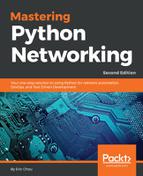Python programs are executed by an interpreter, which means the code is fed through this interpreter to be executed by the underlying operating system and results are displayed. There are several different implementations of the interpreter by the Python development community, such as IronPython and Jython. In this book, we will use the most common Python interpreter in use today, CPython. Whenever we mention Python in this book, we are referring to CPython unless otherwise indicated.
One way you can use Python is by taking advantage of the interactive prompt. This is useful when you want to quickly test a piece of Python code or concept without writing a whole program. This is typically done by simply typing in the Python keyword:
Python 3.5.2 (default, Nov 17 2016, 17:05:23)
[GCC 5.4.0 20160609] on linux
Type "help", "copyright", "credits" or "license" for
more information.
>>> print("hello world")
hello world
>>>
The interactive mode is one of Python's most useful features. In the interactive shell, you can type any valid statement or sequence of statements and immediately get a result back. I typically use this to explore a feature or library that I am not familiar with. Talk about instant gratification!
A more common way to run the Python program, however, is to save your Python file and run it via the interpreter after. This will save you from typing in the same statements over and over again like you have to do in the interactive shell. Python files are just regular text files that are typically saved with the .py extension. In the *Nix world, you can also add the shebang (#!) line on top to specify the interpreter that will be used to run the file. The # character can be used to specify comments that will not be executed by the interpreter. The following file, helloworld.py, has the following statements:
# This is a comment
print("hello world")
This can be executed as follows:
$ python helloworld.py
hello world
$
